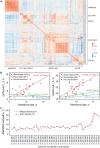Identification of differentially methylated genes in first-trimester placentas with trisomy 16
- PMID: 35064135
- PMCID: PMC8782849
- DOI: 10.1038/s41598-021-04107-9
Identification of differentially methylated genes in first-trimester placentas with trisomy 16
Abstract
The presence of an extra chromosome in the embryo karyotype often dramatically affects the fate of pregnancy. Trisomy 16 is the most common aneuploidy in first-trimester miscarriages. The present study identified changes in DNA methylation in chorionic villi of miscarriages with trisomy 16. Ninety-seven differentially methylated sites in 91 genes were identified (false discovery rate (FDR) < 0.05 and Δβ > 0.15) using DNA methylation arrays. Most of the differentially methylated genes encoded secreted proteins, signaling peptides, and receptors with disulfide bonds. Subsequent analysis using targeted bisulfite massive parallel sequencing showed hypermethylation of the promoters of specific genes in miscarriages with trisomy 16 but not miscarriages with other aneuploidies. Some of the genes were responsible for the development of the placenta and embryo (GATA3-AS1, TRPV6, SCL13A4, and CALCB) and the formation of the mitotic spindle (ANKRD53). Hypermethylation of GATA3-AS1 was associated with reduced expression of GATA3 protein in chorionic villi of miscarriages with trisomy 16. Aberrant hypermethylation of genes may lead to a decrease in expression, impaired trophoblast differentiation and invasion, mitotic disorders, chromosomal mosaicism and karyotype self-correction via trisomy rescue mechanisms.
© 2022. The Author(s).
Conflict of interest statement
The authors declare no competing interests.
Figures





References
-
- Warburton, D., Byrne, J. M. & Canki, N. Chromosome Anomalies and Prenatal Development : An Atlas. (Oxford University Press, 1991).
Publication types
MeSH terms
Supplementary concepts
Grants and funding
LinkOut - more resources
Full Text Sources
Other Literature Sources
Medical

